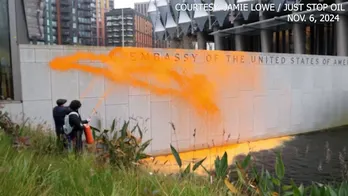What we know about a large dam's catastrophic breach in Ukraine
Water is surging through a massive breach in the Kakhovka dam on the Dnipro River in southern Ukraine, triggering floods, evacuations and worries about crops downriver. It also raises new worries about the safety of the Zaporizhzhia Nuclear Power Plant, which relies on the dam's reservoir to supply water for its cooling operations.
The Zaporizhzhia nuclear facility is dozens of miles north of the dam, in an area where low-lying lands along the river were flooded to create the large Kakhovka Reservoir.
The dam is on the line between Russian and Ukrainian forces
Ukraine controls the western side of the Dnipro River (which is also called the Dnieper), and Russia controls the eastern side, including the Kakhovka Hydroelectric Power Plant.
Ukrainian officials say Russia sabotaged the dam by setting off explosions in the power plant overnight.
Moscow blames Kyiv, saying Ukrainian forces fired on the dam overnight. NATO sides with Ukraine, with Secretary General Jens Stoltenberg accusing Russia of an "outrageous act" in destroying the dam.
New risk for a big nuclear power plant
While details about the extent of the damage to the dam are still emerging, officials in and outside of Ukraine say there is no direct or immediate threat to the Zaporizhzhia Nuclear Power Plant, the largest nuclear plant in Europe.
But they also say the plant's circumstances are more dire than ever, as the reservoir's falling water level is expected to cut off the main supply of water used to cool the plant's reactors and prevent a meltdown.
At 8 a.m. local time, the reservoir stood around 16.4 meters (or nearly 54 feet) according to International Atomic Energy Agency Director General Rafael Mariano Grossi. If the level falls below 12.7 meters (41.6 feet) , "it can no longer be pumped" to the power plant's cooling system, Grossi added.
The reactors have been shut down "for many months," Grossi said. They still require cooling to move residual heat out of their cores, but that requires much less water than normal operations.
In fact, the six reactors only require about a fire hose-worth of water to keep them cool, according to Jacopo Buongiorno, a professor of nuclear science and engineering at MIT.
"The bottom line is that they're not going to run out of that amount of water any time soon," he says.
A crucial goal now, Grossi added in his statement, is to protect the remaining alternative supplies of water for the plant. That includes a large cooling pond near the site along the Russian-held eastern bank, which he said would likely "be sufficient to provide water for cooling for some months."
The structure had already been damaged
The dam has stood since the 1950s, when it created a reservoir about the size of the Great Salt Lake in Utah. It is a vital piece of regional infrastructure, creating electricity and sending water to municipal systems and a network of irrigation canals.
Late last fall, the dam was damaged in the fighting, including a suspected Russian explosive charge that blew up part of the roadway over the dam last Nov. 11, as Russia withdrew from nearby Kherson.
Things got worse this year. On June 2, a road that traverses part of the dam seemingly failed, indicating a potentially far-ranging structural problems. The changes suggest the possibility that a failure, rather than military activity, is what ultimately brought down the dam.
As images from last week show, the road, which runs over a portion of the dam's eastern side, looks to have been washed away.
The breach has destroyed 16 gates, the hydroelectric power station and an earthen dam, Ukrhydroenergo, Ukraine's hydro electric company, said in an update on Tuesday.
In addition to the flooding threat that abruptly caused thousands of people to flee to higher ground, Ukrainian President Volodymyr Zelenskyy's website says at least 150 tons of machine oil used in the plant's turbines was swept into the Dnipro River, with an additional 300 tons at risk of following.
Water levels had been at record highs
By 4 p.m. local time, water submerged 13 settlements and more than 260 houses on the river's right bank, according to Ukrhydroenergo, Ukraine's state hydroelectric company, citing preliminary data. More than 1,339 people were evacuated, it said.
Water rushing from the reservoir won't peak until Wednesday morning, Ukrhydroenergo CEO Igor Sirota said via social media, adding that it would likely take four to five more days after that for water levels to start to recede.
The Kakhovka Reservoir had been holding record amounts of water. In recent weeks, its water levels surged to record highs, in an abrupt shift after levels fell sharply over the fall and winter.
Last year, it had appeared the Russian occupying force was attempting to drain the large reservoir, raising fears in Ukraine that Moscow would imperil drinking water, farm production and safety at the Zaporizhzhia Nuclear Power Plant.
But in the spring, the Russians changed course and didn't let enough water through the structure's sluice gates. By last month, the lake flooded nearby areas and water started to overtop the dam.
Losing the reservoir will create a water crisis
Although flooding in the area downstream of the dam is the most immediate emergency, there are huge upstream implications to losing the dam as well. Towns along the reservoir and throughout the region depend on it for drinking water, says David Helms, a retired U.S. government meteorologist who has been closely tracking conditions at the dam.
"It's a huge water catastrophe," he says. "It'll have to be trucked in... that's a huge challenge."
Water from the reservoir also feeds nearly 1,000 miles of irrigation canals. They're used to water vegetables and cash crops like sunflowers. Going into a hot summer and beyond, Helms and others believe losing this reservoir is going to spark an economic and humanitarian disaster for Ukrainians on both sides of the front lines.
Disclaimer: The copyright of this article belongs to the original author. Reposting this article is solely for the purpose of information dissemination and does not constitute any investment advice. If there is any infringement, please contact us immediately. We will make corrections or deletions as necessary. Thank you.







